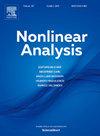具有径向和圆柱对称性的两相模型自由边界问题的解析解
IF 1.3
2区 数学
Q1 MATHEMATICS
引用次数: 0
摘要
本文研究了不粘性两相模型的自由边界问题,其中压力函数为 P(n,ρ)=ργ+nα (γ>1, α≥1),n 和 ρ 分别为两相的密度。首先,我们利用一些解析式构建了 N 维径向对称情况下的一些自相似解析解,并利用平均量方法研究了自由边界的扩散率。其次,我们将 N 维径向对称情况的结果扩展到三维圆柱对称情况。第三,我们给出了具有科里奥利力的三维圆柱对称模型的一些解析解。从本文构建的解析解中,我们发现科里奥利力可以阻止自由边界无限向外扩展。本文章由计算机程序翻译,如有差异,请以英文原文为准。
Analytical solutions to the free boundary problem of a two-phase model with radial and cylindrical symmetry
In this paper, we study the free boundary problem of an inviscid two-phase model, where we take the pressure function as (, ) with and being the densities of two phases. First, we construct some self-similar analytical solutions for the -dimensional radially symmetric case by using some ansatzs, and investigate the spreading rate of the free boundary by using the method of averaged quantities. Second, we extend the results of the -dimensional radially symmetric case to the three-dimensional cylindrically symmetric case. Third, we present some analytical solutions for the three-dimensional cylindrically symmetric model with a Coriolis force. From the analytical solutions constructed in this paper, we find that the Coriolis force can prevent the free boundary from spreading out infinitely.
求助全文
通过发布文献求助,成功后即可免费获取论文全文。
去求助
来源期刊
CiteScore
3.30
自引率
0.00%
发文量
265
审稿时长
60 days
期刊介绍:
Nonlinear Analysis focuses on papers that address significant problems in Nonlinear Analysis that have a sustainable and important impact on the development of new directions in the theory as well as potential applications. Review articles on important topics in Nonlinear Analysis are welcome as well. In particular, only papers within the areas of specialization of the Editorial Board Members will be considered. Authors are encouraged to check the areas of expertise of the Editorial Board in order to decide whether or not their papers are appropriate for this journal. The journal aims to apply very high standards in accepting papers for publication.

 求助内容:
求助内容: 应助结果提醒方式:
应助结果提醒方式:


